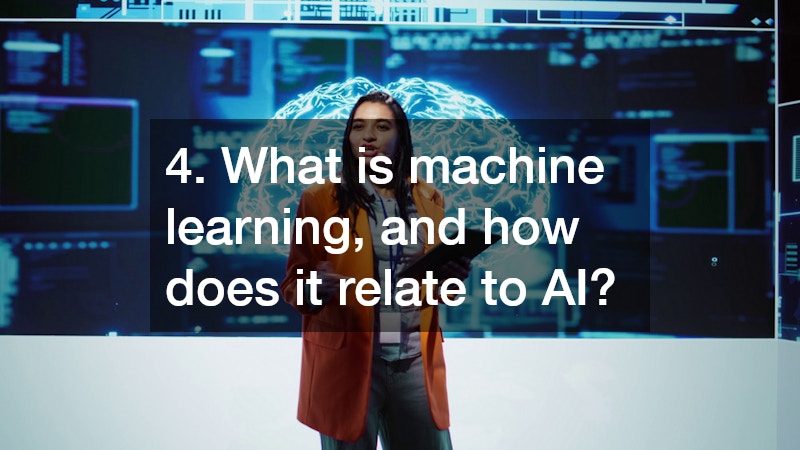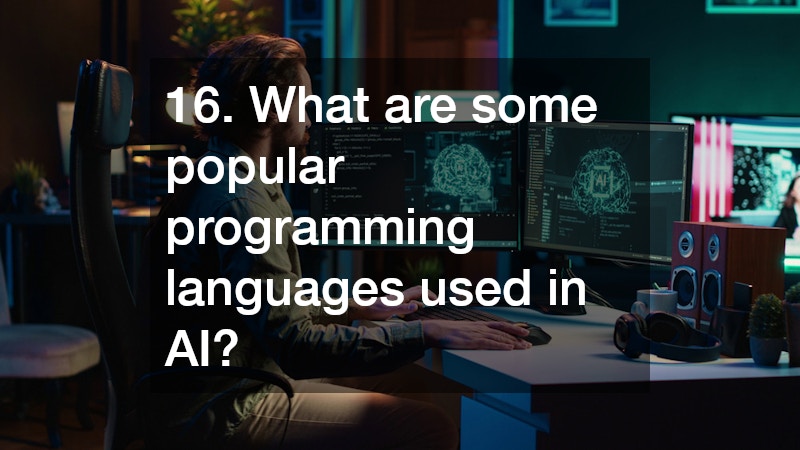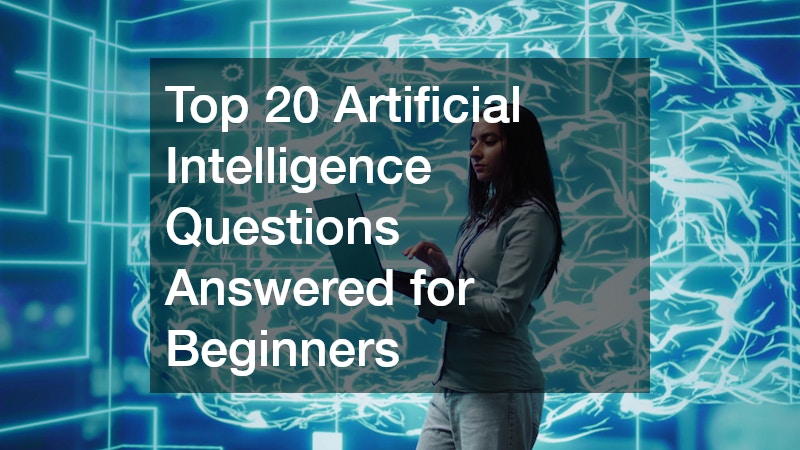Artificial Intelligence (AI) is no longer a distant concept from science fiction—it’s part of our everyday lives. From virtual assistants to recommendation algorithms on Netflix, AI is quietly working behind the scenes to make our digital experiences more intuitive and personalized. But for beginners curious about this fast-evolving technology, the subject can be overwhelming. What exactly is AI? How does it work? Will it replace human jobs? These are just a few of the many artificial intelligence questions that are commonly asked by newcomers.
In this article, we’ll break down 20 of the most common AI questions people ask when they’re first introduced to the technology. Whether you’re a student, professional, or just a curious learner, this guide will help you understand the basics of AI and where the future is headed.
1. What is Artificial Intelligence?
Artificial Intelligence involves creating machines designed to imitate human cognitive abilities like thinking, learning, and solving problems. These systems are capable of processing data, identifying patterns, and making decisions autonomously, often requiring minimal human guidance.
Essentially, AI aims to replicate mental processes such as reasoning and adapting to new information. It supports a wide range of applications—from simple virtual assistants that handle routine inquiries to advanced technologies that interpret medical scans. Grasping the concept of AI lays the groundwork for understanding its diverse uses and the impact it may have moving forward.
2. How is AI different from regular computer programs?
Traditional programs follow explicit instructions—step-by-step rules coded by humans. AI systems, on the other hand, learn from data. They can adapt, improve over time, and make decisions based on past experiences, just like humans.
While a regular program performs fixed tasks precisely as coded, AI can handle uncertain or incomplete information. This means AI can recognize speech, translate languages, or even suggest movies based on your preferences. The ability to learn and evolve sets AI apart from traditional software, making it more flexible and powerful.
3. What are the main types of AI?
AI is generally categorized into three types:
- Narrow AI: Performs specific tasks (e.g., facial recognition, language translation).
- General AI: Can perform any intellectual task a human can do (still theoretical).
- Superintelligent AI: Surpasses human intelligence in all aspects (currently speculative).
Narrow AI is what we encounter today in most applications, designed to excel in one area. General AI, often called strong AI, remains a goal for researchers aiming to create machines with human-like reasoning across diverse domains. Superintelligence, while mostly speculative, raises philosophical and ethical questions about the future of AI development.
4. What is machine learning, and how does it relate to AI?

Machine Learning (ML) is a specialized area within artificial intelligence that enables computers to gain insights from data and improve over time without being given specific instructions for every task. You can think of it as the part of AI that helps machines recognize patterns, make informed decisions, and adapt their behavior based on what they’ve learned.
Machine learning models are trained using large datasets to identify trends and make predictions. For example, ML algorithms can help diagnose diseases from medical scans or recommend products based on shopping history. It is one of the most active fields within AI research and application.
5. Is AI the same as automation?
Not exactly. Automation involves using machines or software to carry out tasks without human input. AI enhances automation by allowing machines to make intelligent decisions and adapt to new situations.
While automation executes repetitive tasks efficiently, AI-powered automation can handle more complex problems requiring judgment, such as fraud detection or customer support. This distinction means AI is expanding the scope and intelligence of automated systems beyond simple rule-based processes.
6. Where is AI used in everyday life?
You might not even realize it, but AI is embedded in daily tools and services. Examples include:
- Voice Assistants like Alexa or Siri
- Email spam filters
- Netflix and YouTube recommendations
- Google Maps traffic predictions
- Face recognition in smartphones
These examples illustrate how AI improves convenience and personalization in our lives. From suggesting what to watch next to helping drivers avoid traffic jams, AI makes technology more responsive and user-friendly without requiring constant human input.
7. What is natural language processing (NLP)?
Natural Language Processing (NLP) is a branch of artificial intelligence that allows computers to process and make sense of human language in a meaningful way. This technology powers a variety of tools and applications, including virtual assistants, customer service chatbots, language translation services, and writing enhancement platforms that suggest grammar and style improvements.
NLP combines linguistics and machine learning to understand context, sentiment, and intent in text or speech. It is essential for enabling computers to interact with humans in a natural, conversational manner, bridging the communication gap between humans and machines.
8. Can AI think like a human?
Not yet. While AI can mimic certain cognitive functions, it lacks consciousness, emotion, and true reasoning. It processes information in fundamentally different ways from the human brain.
Current AI systems operate based on algorithms and data, without self-awareness or genuine understanding. Although AI can simulate conversation and decision-making, it does so without feelings or intuition. The question of whether AI can ever truly “think” like humans remains a topic of debate in philosophy and technology.
9. What is deep learning?
Deep learning is a subset of machine learning that uses neural networks with many layers to analyze complex patterns. It’s behind innovations like self-driving cars, image recognition, and voice synthesis.
By mimicking the structure of the human brain, deep learning models can automatically extract features from raw data, improving their accuracy with vast amounts of information. This ability has revolutionized fields such as healthcare diagnostics, natural language understanding, and autonomous vehicles.
10. Are AI and robotics the same?
They often work together, but they’re not the same. Robotics involves building physical machines, while AI is the intelligence that can be embedded within those machines. For example, a robot vacuum may use AI to navigate your home intelligently.
Robots can operate without AI if they follow simple, pre-programmed paths. However, integrating AI allows robots to adapt to their environment, recognize objects, and make decisions on the fly. This synergy enhances automation and opens new possibilities for robotics applications.
11. What are the risks of AI?
Some common concerns include:
- Job displacement due to automation
- Bias in AI algorithms due to skewed training data
- Privacy concerns from data collection
- Loss of human control over decision-making
While AI offers tremendous benefits, these risks highlight the importance of responsible development. Ethical guidelines, transparency, and regulation are critical to ensuring AI systems are fair, secure, and aligned with human values.
12. Will AI take over all jobs?
AI will automate repetitive and predictable tasks, but it’s more likely to augment rather than replace most jobs. New roles will emerge, especially in AI ethics, maintenance, and development.
Instead of total job loss, many experts foresee a shift where AI handles routine work while humans focus on creativity, critical thinking, and interpersonal skills. Reskilling and education will play a key role in adapting to this changing job landscape.
13. How do machines learn from data?
AI systems use training data to recognize patterns. For example, to teach an AI to identify cats in photos, it’s fed thousands of labeled cat images. Over time, it learns to distinguish features and generalizes to new, unseen images.
This training process involves adjusting internal parameters to minimize errors. The quality and quantity of data significantly impact how well the AI performs. Continuous learning and updating help AI adapt to new challenges and environments.
14. What is an algorithm in AI?
An algorithm is a set of instructions that an AI follows to perform tasks, analyze data, or make decisions. In AI, algorithms help systems determine what actions to take based on inputs.
Different AI problems require different types of algorithms, such as decision trees, neural networks, or reinforcement learning methods. The choice of algorithm affects the efficiency, accuracy, and interpretability of AI models.
15. Can AI be biased?
Yes. If AI is trained on biased or incomplete data, it can inherit those biases. For instance, facial recognition tools have shown racial biases due to a lack of diversity in training data. That’s why ethical AI development is crucial.
Addressing bias requires diverse datasets, transparency in model design, and ongoing monitoring. Ethical AI aims to reduce discrimination and promote fairness, ensuring technology benefits all users equally.
16. What are some popular programming languages used in AI?

Some widely used languages in AI development include:
- Python – Most popular due to its libraries like TensorFlow and PyTorch
- R – Excellent for statistical analysis
- Java – Often used in enterprise-level AI systems
- C++ – High-performance applications like gaming or real-time systems
Python’s simplicity and extensive community support make it the preferred choice for many AI practitioners. Other languages are chosen based on specific project needs, such as speed, scalability, or domain requirements.
17. How can someone start learning AI?
Begin with foundational topics like:
- Basic statistics and math
- Intro to Python programming
- Online courses on platforms like Coursera, edX, or Udacity
- Hands-on projects using open-source AI libraries
Starting with clear goals and gradually tackling more complex concepts can help beginners build confidence. Joining AI communities and attending workshops also provides valuable networking and learning opportunities.
18. What are neural networks?
Neural networks are algorithms inspired by the structure of the human brain. They consist of layers of “neurons” that process and transmit information. They’re essential to deep learning and enable complex tasks like language translation and image recognition.
By adjusting the connections between neurons during training, neural networks learn to recognize patterns in data. This flexibility allows them to handle unstructured data such as images, audio, and text with remarkable accuracy.
19. What’s the difference between supervised and unsupervised learning?
- Supervised learning: Uses labeled data (e.g., spam vs. not spam).
- Unsupervised learning: Finds patterns in unlabeled data (e.g., customer segmentation).
Both are essential machine learning methods used in various AI applications. Supervised learning is common in classification and regression tasks, while unsupervised learning helps discover hidden structures in data, useful for clustering and anomaly detection.
20. Why is there so much hype around AI right now?
Because it’s transforming every industry, from healthcare and finance to entertainment and education, AI is accelerating problem-solving, creating new economic opportunities, and reshaping how we interact with technology. The breakthroughs in generative AI, language models (like ChatGPT), and computer vision have made AI more accessible and relevant than ever.
The rapid advances, combined with increased computing power and vast data availability, have created a surge of innovation and public interest. This excitement drives investment and exploration, further fueling AI’s development.
Common Artificial Intelligence Questions from Beginners – Answered Clearly
Beginners often hesitate to dive into AI due to its technical nature. But asking questions is the first step to understanding this revolutionary technology. To recap, here are some frequently asked artificial intelligence questions that provide a great starting point:
- What is AI, and how does it differ from automation?
- Can AI think like humans?
- Where is AI used in real life?
- Is AI dangerous or biased?
- How do I get started learning AI?
Asking the right questions leads to a clearer understanding and empowers anyone, regardless of background, to explore the world of artificial intelligence.
Final Thoughts: Why You Should Keep Asking Questions About AI
Artificial Intelligence isn’t just a buzzword—it’s shaping the world around us in profound ways. Whether you’re interacting with a chatbot, shopping online, or using your smartphone, AI is influencing your experience. As technology evolves, so do the questions we need to ask.
By staying curious and informed, you can better navigate the digital future, participate in meaningful conversations about technology, and maybe even contribute to the development of more ethical, innovative AI systems.
